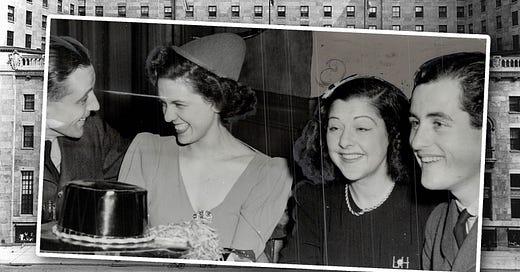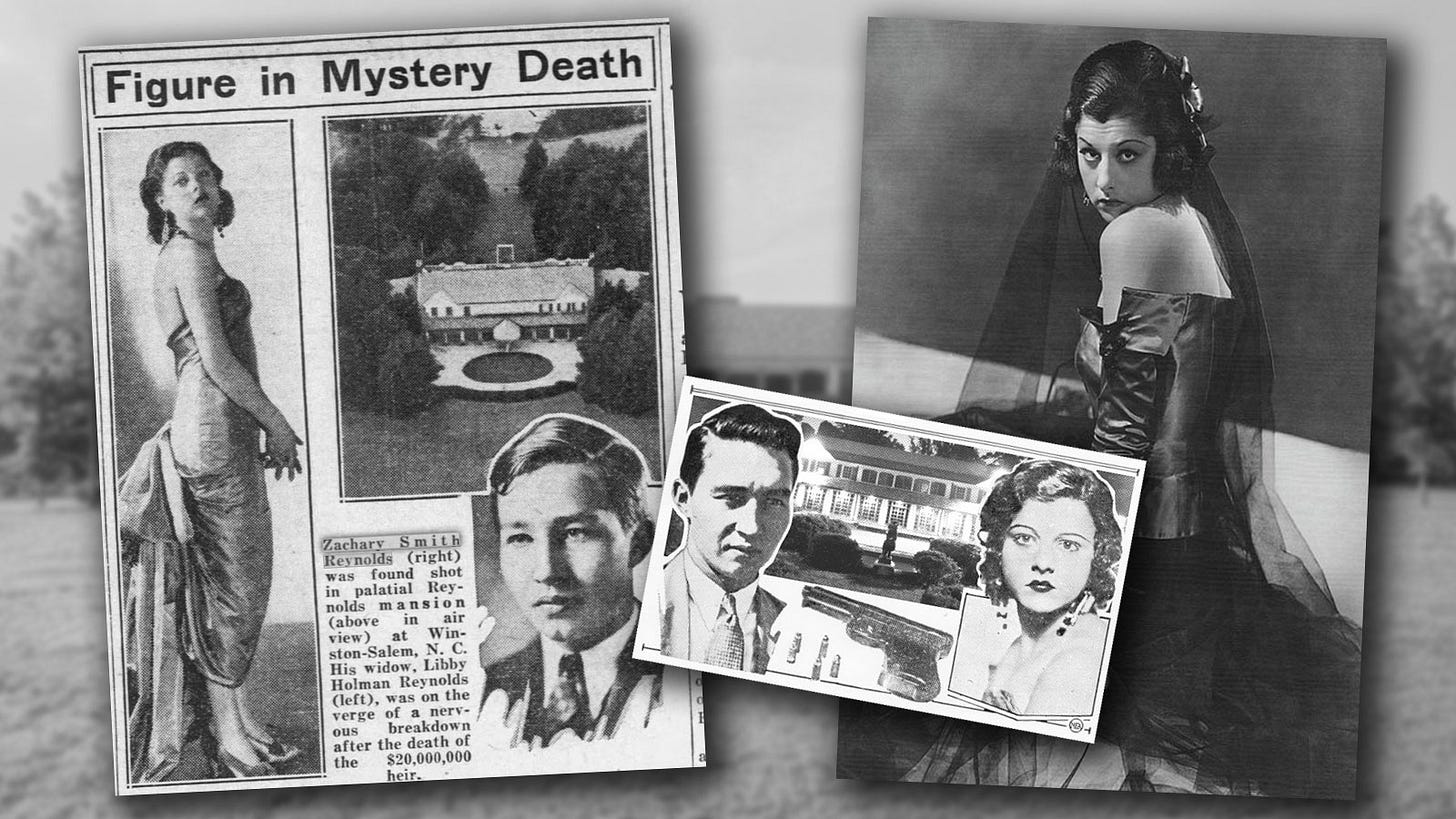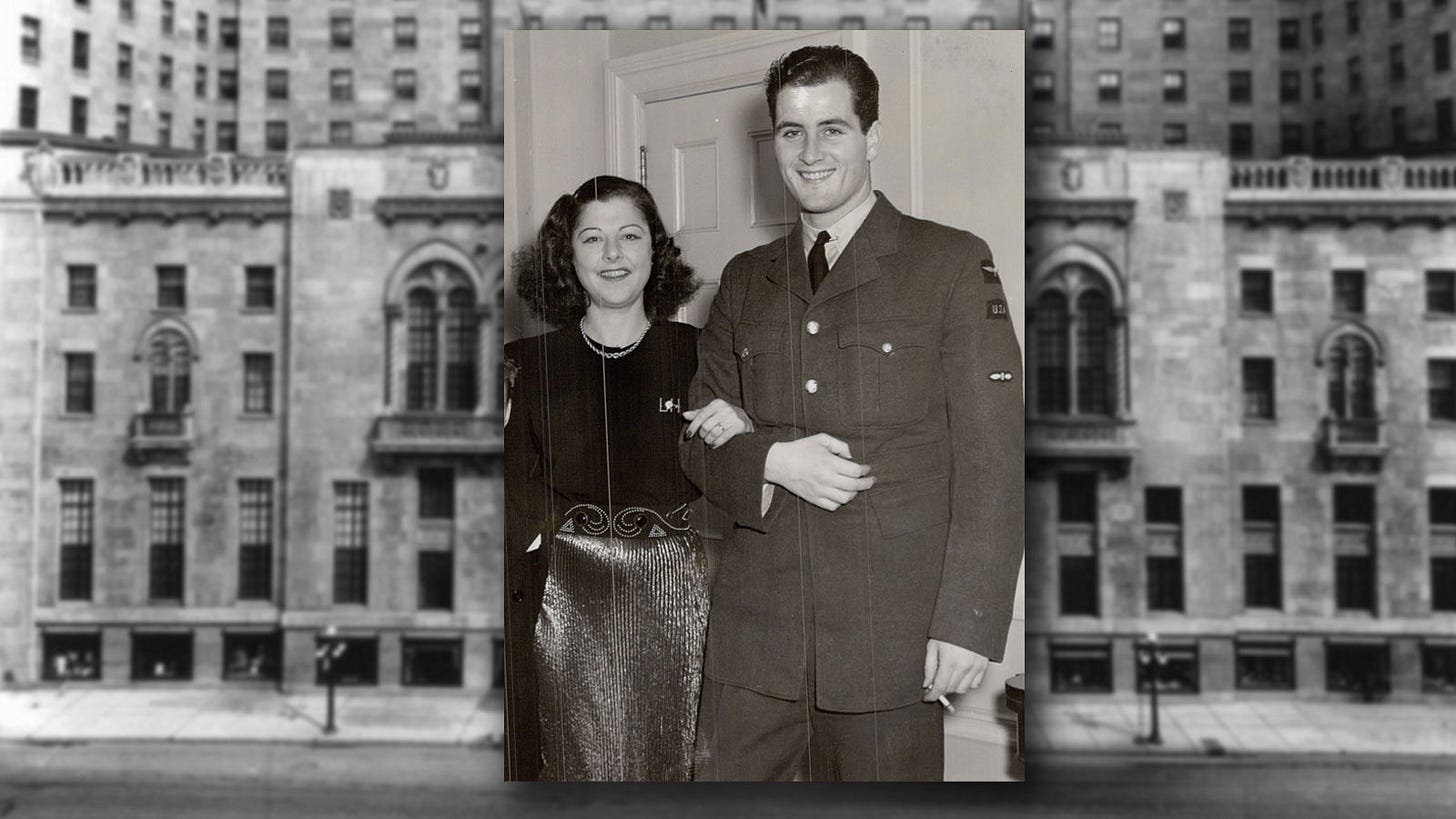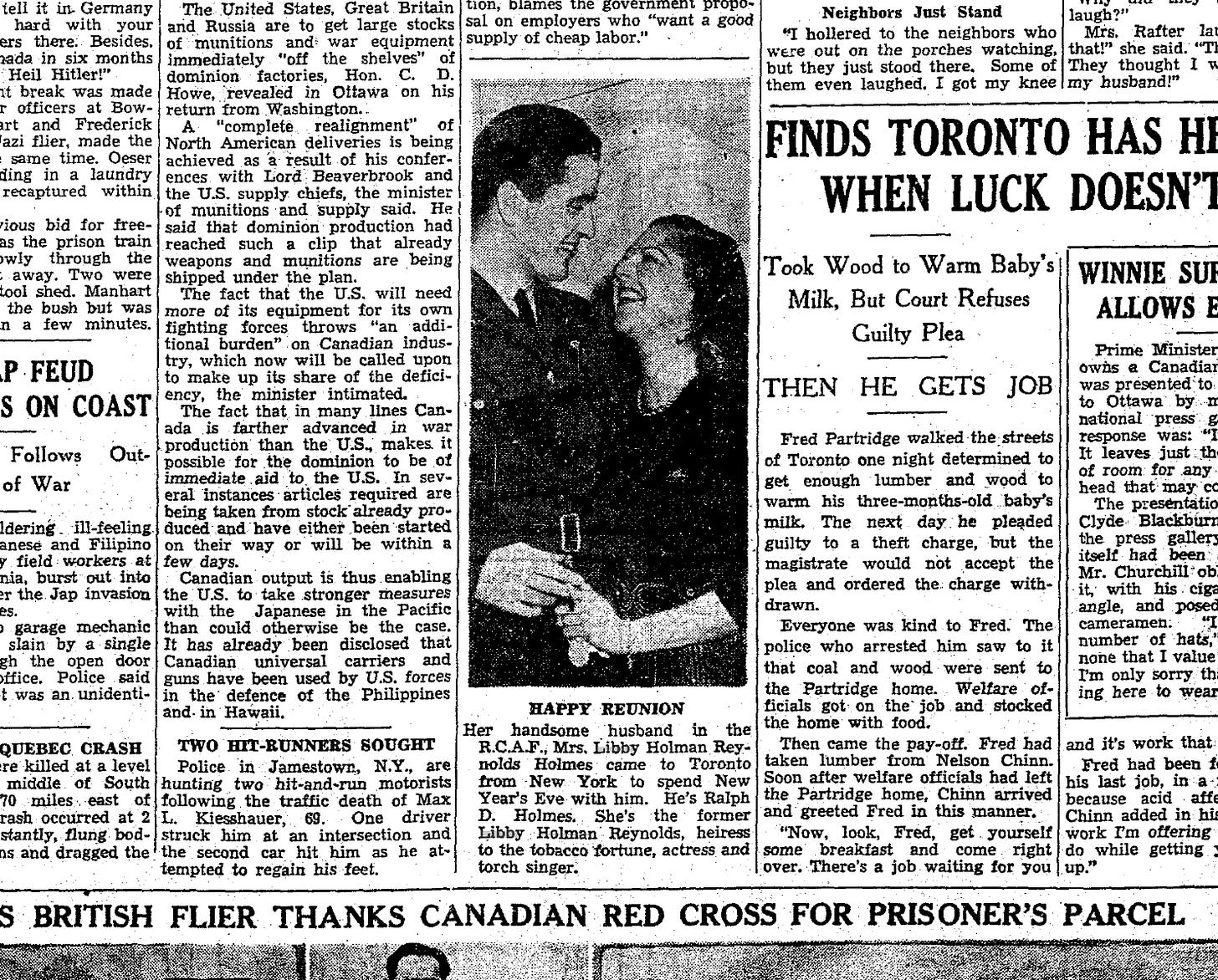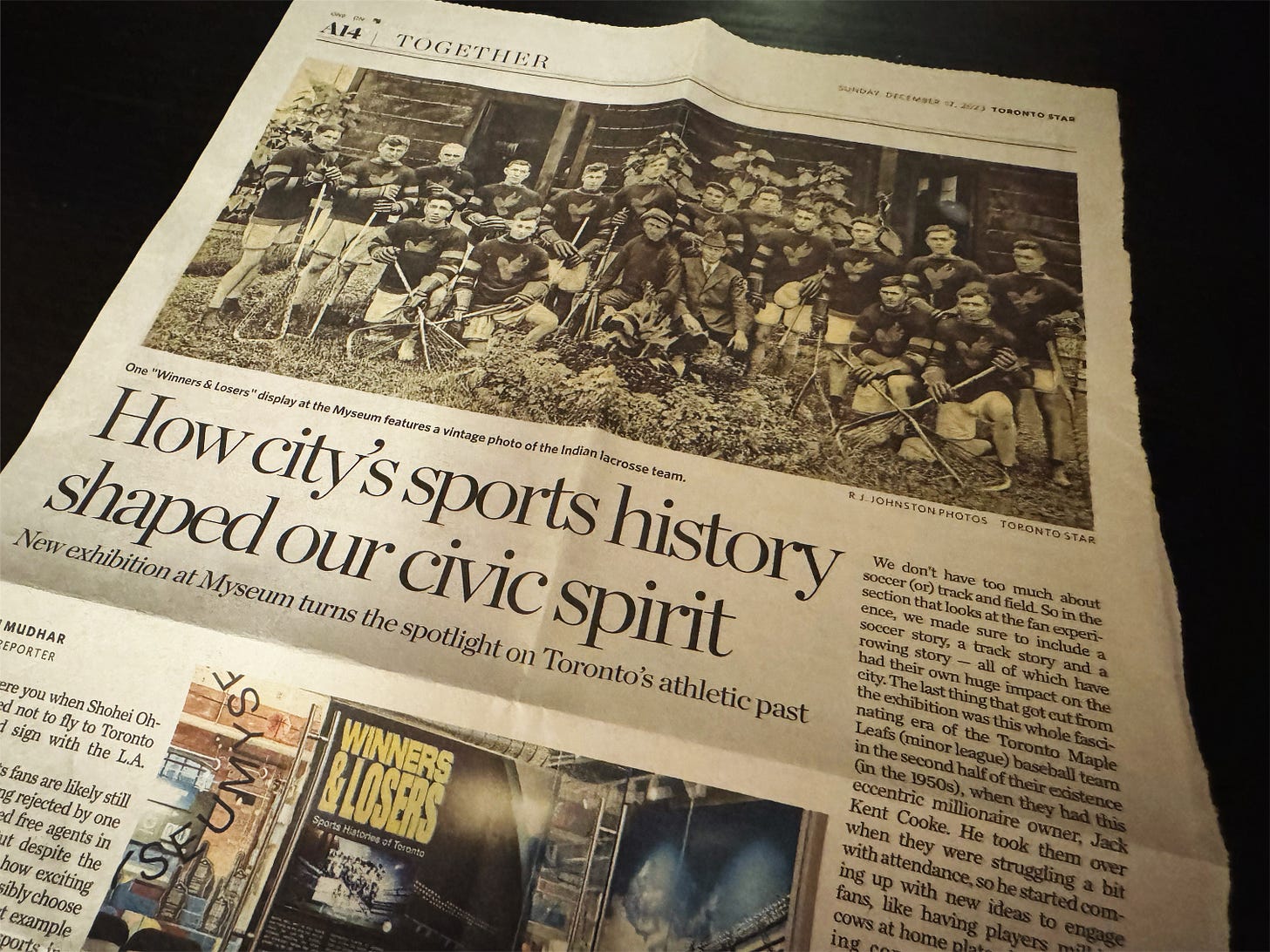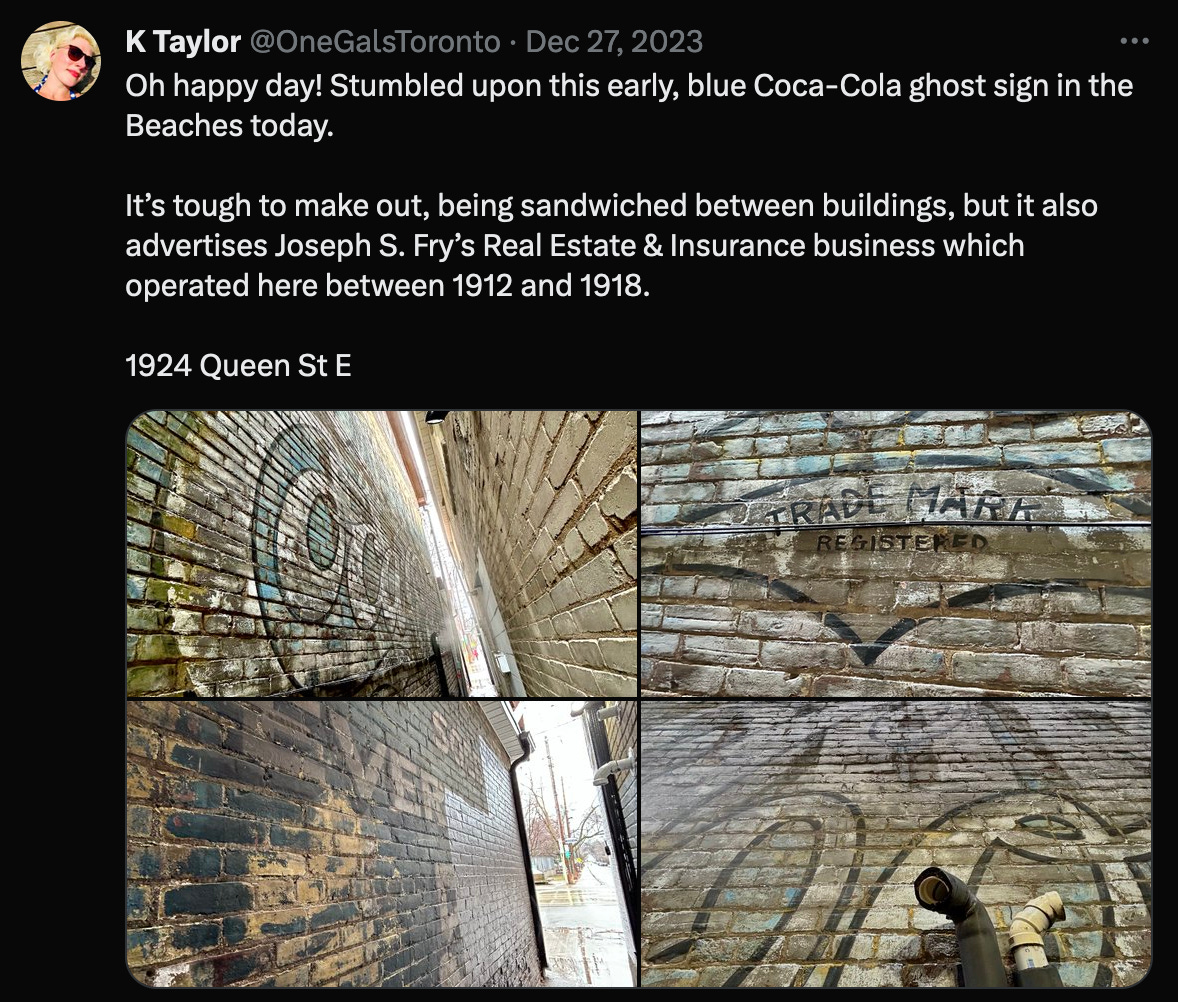A Tragic Tale of Scandal, War, Broadway Stars & Betrayal
Plus ancient remains uncovered in Riverdale, the future of Old City Hall, and more...
This photo was taken on New Year's Eve at the Royal York Hotel. When I first stumbled upon it, I assumed it was an ordinary picture of revellers ringing in 1942. But as it turns out, there's actually a wild story behind this photograph — a tragic tale of scandal, war, Broadway stars, and betrayal.
The woman on the right is Libby Holman. She was one of Broadway's brightest stars in the 1920s and '30s — a singer, actor, socialite and fashion icon. She appeared in plays, musicals and films and has been called "a photographer's pride and a photographer's heaven." Some give her credit for inventing the strapless dress — at the very least, she helped popularize it as her signature look. And she was fodder for gossip pages, too, as one of New York City's most notorious party animals. She took lovers, made enemies, and knew how to leave an impression.
Holman partied her away through glitzy galas, opera openings, Harlem jazz clubs, and fancy Manhattan super clubs. Her own parties were so over the top that hotels began to refuse her bookings. Take, for instance, the bacchanalian birthday bash she threw for her six-year-old son. It went all night. Jazz stars like Billie Holiday, Benny Goodman and Gene Krupa performed. "That was one hell of a party," Holiday later remembered, "the way a party's supposed to be."
Not everyone loved Holman. She was as sharp-tongued as she was quick-witted. When she performed in a big Cole Porter musical called You Never Know, her co-star Lupe Velez hated her with such a passion that Velez started pissing in the wings of the stage, hoping Holman would slip and fall in the puddle. But while some despised her, others fell madly in love with her.
One Broadway producer called her an "irresistible enchantress [who] could exert a strange fascination." Many men are said to have followed her around "like puppies." She had affairs with loads of them — some, like Montgomery Clift, scandalously young. And Holman was just as interested in women — if not more so. She had a long romance with DuPont heiress Louisa Carpenter, a tempestuous affair with the famous actor Tallulah Bankhead, and there were even rumours she was sleeping with Josephine Baker.
Her first husband was the heir to a big tobacco company — the one that made Camels, Newports and Pall Malls. He, like so many others, was hopelessly devoted to Holman. Whenever they were forced to spent time apart for work, he plunged into a terrible depression, threatening to kill himself. The marriage didn't last. He died under suspicious circumstances, shot in the head after the couple had a big fight at a party. Some said it was suicide. Others, including the coroner, thought he'd been murdered.
It was a just few years later that Libby Holman fell in love with the man on the far left in the photo. His name was Phillips Holmes. He was a fellow actor from a family filled with big Broadway stars, including his mother — a theatre actor from Canada.
Holmes, too, was obsessed with Holman. He desperately wanted to get married. But she knew it would never work; he was far too traditional, wanting to be the breadwinner while she gave up her career to stay at home. When she got pregnant, she hid it from him; she had an abortion and never told him. Their relationship didn't last long after that. They fought more and more. Finally, in the spring of 1938, she kicked him out of the house. Phillips was soon found by friends living at the Ritz Hotel in London: drunk, unshaven, sick, his bed soaked in urine and vomit. He was desperate for any news of Holman. A whole wall of his hotel room was plastered with photos of her.
Little did he know the awful truth. Libby Holman had been having an affair with Phillips' own brother: Ralph Holmes, the man on the far right in the photo.
Libby and Ralph got married a year after she and Phillips broke up. It wasn't an easy marriage. Not only was he her ex-lover's brother, he was also eleven years younger (23 to her 34) and homophobic (which meant he didn't get along with many of her friends). But she was still truly deeply in love with him.
It was the outbreak of the Second World War that finally drove them apart. Ralph was determined to join the fight even though the United States had yet to enter the war. Since he was half Canadian, he could head north and enlist with the Royal Canadian Air Force. Libby tried to talk him out of it, but he wouldn't listen. He spent the next three years training pilots on a military base in Hamilton. He and Holman barely ever got to see each other.
The photo of New Year's Eve at the Royal York Hotel is one of the fleeting moments they did get to spend together during those hard years apart. Phillips was even there, doing his best to forgive them. They all rang in 1942 together, along with the second woman in the photo: Ethel Barrymore Colt — daughter of the famous actor Ethel Barrymore, cousin-once-removed of Drew Barrymore, and a performer in her own right — who was in Toronto to perform in a show at the Royal Alexandra Theatre.
But it was only a brief flash of happiness. Both brothers were doomed… and the clock was ticking.
It was Phillips who would die first. He had also joined the Royal Canadian Air Force; he'd enlisted earlier that same week, on Boxing Day. When that New Year's Eve photo was taken, he was about to head off to Regina for his training. When he passed his flight test, he called Holman one last time knowing he was about to head off to war. She didn't answer the phone. He was forced to leave a message with her maid. It was his final farewell.
Days later, he took his last flight. Shortly after taking off from a base in Northern Ontario, his plane smashed into another aircraft in midair. There were no survivors. Holman soon came back to Toronto. This time, it was with his sister to collect her ex-lover's body.
Ralph would live a little longer. He saw the end of the war, but only barely. Before he died, he and Libby were torn even further apart. The RCAF sent him to England. He eventually transferred to the U.S. Air Force and spent the last two years of the war flying bombing runs over Germany. He and Holman didn't get to see each other at all during that time.
They had an open marriage, promising to tell each other about all the people they slept with. During the war, Holman had more affairs than ever before, random hook-ups with strangers, waiters, maître d's, truck drivers... "Libby's carnality was unbridled and obstinate," according to her biographer, Jon Bradshaw. "Men…were little more than rash adventures." And Holman told Ralph all about it in her letters, while he wrote back about what it was like to sleep with French women, Italians, Swedes… But the big blow came when Holman got a letter from a woman Ralph had never mentioned, claiming they'd fallen in love. It was a deep betrayal, a shattering of the trust they'd built. The marriage deteriorated from there.
When the war ended and Ralph finally came home, Libby was still elated to see him — she threw a series of massive all-night bashes to celebrate. But he hated them; exhausted by the horrors of war, he just wanted some quiet time to get to know each other again. He started drinking more. Put on weight. Got hooked on sleeping pills, wanting to spend as little time as possible awake to escape his memories of the war. The physical attraction Holman had once felt so strongly for him faded away. They barely slept together at all anymore.
They separated the very same month the war came to an end. Just months after that, his body was found in his Manhattan apartment; he'd been killed by an overdose of barbiturates. He was 29 years old. To this day, no one's sure whether it was an accident or suicide.
As for Libby Holman, she would live another twenty years — and make good use of that time. While Ralph was away at war, she'd become interested in singing blues music. She became an early white ally in the fight for Civil Rights, demanding night clubs allow her to play with Black musicians. She would eventually become good friends with Martin Luther King Jr. and his wife, Coretta Scott King. Holman created a charitable foundation to support the cause financially — and also championed environmentalism, human rights, and the peace movement.
When King was assassinated, it hit Holman hard. So did the killings of the Kennedys and the mass deaths of the Vietnam War. The grief mounted as her son died, and her old dear friend Montgomery Clift, too. It all took a terrible toll on her mental health. On a June day in 1971, Libby Holman was found in the front seat of her Rolls Royce, having poisoned herself with carbon monoxide. A truly remarkable life had come to a deeply tragic end.
But in the archives of The Toronto Star, you'll find a touching reminder of happier times... There's another photo from that New Year's Eve at the Royal York Hotel. In it, Libby Holman is beaming up at her half-Canadian husband, enjoying one last celebratory night before it all went wrong.
If you’d like to learn more about Libby Holman, Jon Bradshaw’s biography is called Dreams That Money Can Buy: The Tragic Life of Libby Holman. You can borrow it from the Internet Archive here.
And just in case you’d like more stories of romance and heartbreak from the history of Toronto, I’ll take this chance to plug my own Toronto Book of Love, which is available from all the usual places.
The Toronto History Weekly is only able to survive because of those of you willing to support it with a few dollars a month. If you’d like to switch to a paid subscription, all you have to do is click the button below. Only about 4% of readers have made the switch so far, which basically means that with your subscription, you’ll be giving the gift of Toronto history to 25 other people:
I’m Going To Be On The Radio Every Week!
I’ve had a lot of fun popping on Newstalk 1010 from time to time, most often as a guest on The Rush With Reshmi Nair — and now it’s going to be a regular thing! I’ll be showing up every Tuesday afternoon at 3:20pm to share a little bit of Toronto history.
Being a regular radio guest is something I’ve kind of dreamed about ever since I was kid growing up with the CBC on in our kitchen every day, so I’m preeeetty excited about it. You can tune in live at 1010AM on your dial (and 3:20pm on your clock), or listen live online here!
I Talked To The Toronto Star About Our Toronto Sports History Exhibit!
“Winners & Losers: Sports Histories of Toronto” — the exhibit I co-curated for Myseum — is now into its second month. And we got another wonderful bit of press just before the holidays. I had a chat with Raju Mudhar The Toronto Star about the exhibit and some of the thinking behind it. It got a nice big spread in the print edition, but you can check it out outline too — right here.
There’s still plenty of time to check out the exhibit yourself — it’s open for another couple of months — and if you’d like to get a tour of the exhibit, we’ll be offering one in a couple of weeks! On Saturday, January 20, Morgan and I will be leading a couple of tours through the exhibition, sharing some of our favourite stories and a bit about how it all came together. It’s free with registration! The tours are happening at 1pm and 3pm; you can register here.
Here’s everything else you need to know if you’d like to check out the exhibit:
How much: It’s free! (Though donations to Myseum are welcome.)
Where: Myseum of Toronto, which is inside 401 Richmond (right across the hallway from the Spacing Store).
When: It’s open Wednesday–Saturday, 12–6pm, and runs until March 9.
QUICK LINKS
The best of everything else that’s new in Toronto’s past…
ANCIENT BURIAL NEWS — Big news out of Riverdale this weekend. An ancient Indigenous burial ground was uncovered while workers were installing a water line near Broadview & Withrow. Construction has now been paused while the site is investigated. It’s not far from one of the most remarkable archaeological sites in the city: the Withrow Site was uncovered in the late 1800s, with artifacts and human remains both from 4,000 years ago and from a more recent First Nations village thought to have stood on the spot in the 1400s or 1500s. Another reminder that Indigenous people have been living here since a time thousands and thousands of years before the modern city was founded. Read more.
TICKING CLOCK NEWS — The clock is ticking for thousands of Toronto’s oldest buildings. In The Toronto Star, Raju Mudhar gives an update on the recent overhaul to heritage laws by Doug Ford’s provincial government, “effectively eliminating a designation that covers almost a third of the buildings on Toronto’s heritage register.” Municipalities were basically given two years to upgrade the protection offered to each site or risk losing them to demolition — a task so gargantuan it seems impossible. There are 4,000 properties that urgently need to be assessed and the city is usually only able to get through a few per month.
As Mudhar points out, the buildings affected include Convocation Hall, the Wheatsheaf Tavern, Robarts Library, Little Trinity Church, and the Science Centre — though aside from that last one, it seems more likely that less famous sites would actually face a threat from the wrecking ball. The clock started ticking on January 1, 2023 — so we’re now more than halfway to the deadline. Read more.
I also wrote more about the changes back when they were first introduced here.
SANKOFA NEWS — The chair of Yonge-Dundas Square has resigned over the decision to rename the space, but not because he disagreed with it. As Ben Spurr reports in The Toronto Star, it’s because he felt the rushed process “gave the public and the board no opportunity to weigh in.” Read more.
I also wrote about the renaming and the bizarrely sudden turn it took last month in the newsletter a couple of weeks ago.
OLD CITY HALL NEWS — Ben also writes about the unclear future of Old City Hall. As he puts it: “From the grim basement cells to the stately elegance of its clock tower, from its hallowed council chamber to the curiosities lurking in its attic, the building is a repository of more than a century of civic history, both high and low. But its future is in doubt and, without a clear plan to preserve the site, its stories risk being lost.” Read more.
STROLL NEWS — Wonderful news for Toronto flâneurs. Shawn Micallef has been working on an updated version of Stroll. First published back in 2010, his psychogeographic joy of a book is filled with walks around the city. The new edition will be out in May and is already available for presale. Learn more.
MORE CASTLE FRANK NEWS — On his Scenes of Toronto blog, Bob Georgiou has now published the second part of his deep dive into the fascinating history of the Castle Frank neighbourhood. Part One. Part Two.
BOOZE NEWS — Jamie Bradburn had a pair of boozy new pieces for TVO over the holidays. One about the history of Ontarians’ holiday drinking habits here and another about how close the province came to allowing alcohol to be sold in corner stores back in the 1980s here.
LAYERED NEWS — In his
newsletter, Dylan Reid shares a few thoughts about a relatively unremarkable old building on the Danforth, slated for demolition as part of the Ontario Line construction, and the story it reveals. Read more.GHOST SIGN NEWS — Katherine Taylor found a particularly nifty hidden ghost sign in the Beaches over the holidays:
(Click to open in Twitter.)
REALLY VERY HIGH NEWS — Jack Landau writes about one of Toronto’s lost observation decks, which once stood 57 storeys above the city, high atop Commerce Court North. Read more.
MOSS PARK RUINS NEWS — Landau also recently wrote about the ruins uncovered during the subway construction happening at Moss Park: the foundations of a row of commercial buildings from the 1800s. Read more.
DEMOLITION NEWS — And he also writes about the unfortunate fate of one of the coolest-looking old buildings at the newly renamed Sankofa Square. 38 Dundas East has been standing on that spot for more than a century (and currently boasts one of Emily May Rose’s delightful raccoon murals) but it now looks like it’s doomed. Read more.
TORONTO HISTORY EVENTS
MICHAEL SNOW: CELEBRATION OF LIFE
January 10 — 7pm — Art Gallery of Ontario
“Michael Snow (1928-2023) was a legendary Canadian artist whose highly acclaimed and influential practice spanned all media, including painting, drawing, sculpture, photography, film, video projection, sound art, bookmaking and experimental music. This free event will include remembrances of his friends, family and colleagues, and photos and film and video footage of Snow through the decades.
Free with registration!
FIELDS OF SNOW: THE FORMATIVE YEARS
January 12 — 7pm — Art Gallery of Ontario
On Friday, January 12, join us for a free screening of Fields of Snow: The Formative Years, which looks back on the artist Michael Snow's early jazz days before Walking Woman and Wavelength.”
Free with registration!
THE LIFE & TIMES OF ALFRED LAFFERTY
March 21 — 7:30pm — Montgomery’s Inn — The Etobicoke Historical Society
“In 1869 Alfred M. Lafferty, M.A., Richmond Hill, was a witness to the marriage of William Denis Lafferty, a black farmer who lived in Etobicoke. Who was the man with the same surname and a university degree? Hilary J. Dawson’s research uncovered the story of the Lafferty family, and the successes, challenges, and tragedies they faced. The Lafferty parents arrived from the United States in the 1830s as freedom-seekers and their two older sons later farmed in Etobicoke. The youngest son, Alfred, won prizes for excellence at both Upper Canada College and the University of Toronto. Alfred M. Lafferty would be the first black High School Principal in the province. Later, he became the first Canadian-born black lawyer in Ontario.”
Free for members; annual memberships cost $25

